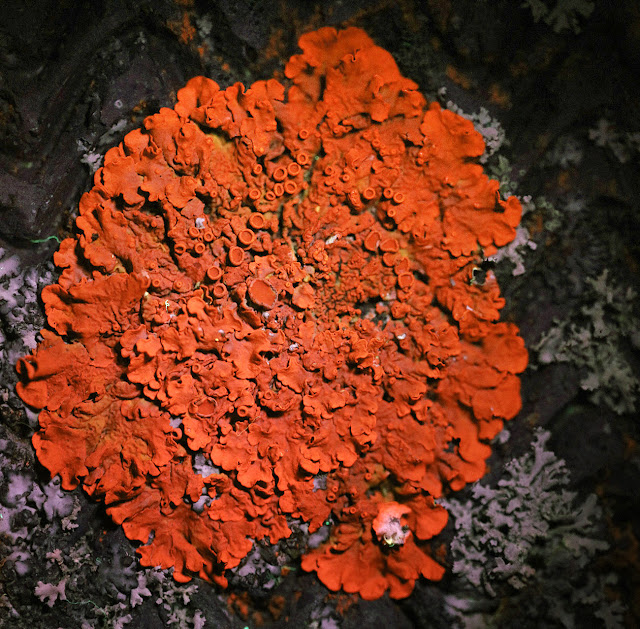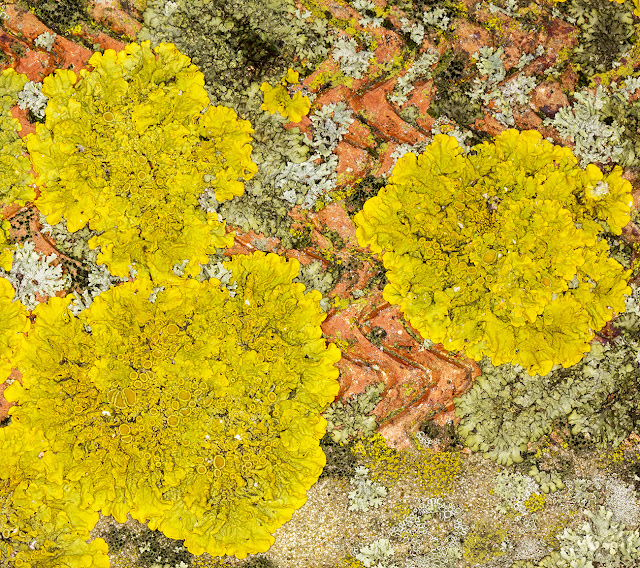 |
| Xanthoria parietina on a brick wall in Hayes by UV light. 21 January 2017. |
Some lichens light up in vivid colours under ultraviolet light. You have to go out in dark night to see this properly. This can be an aid to identification, but the most vivid ones are pretty easy to identify anyway ..
 |
| Xanthoria parietina on a brick wall in Hayes in daylight. 22 January 2017. |
The top photo is the right-hand patch of this vividly coloured lichen, Xanthoria parietina. I have adjusted the photo considerably to bring it to roughly what the naked eye sees. The camera does not pick up the UV light, but there is a strong visible mauve light that goes along with it when the UV torch shines, and I balanced that out. (I have put the technique I used at the bottom of this post.) The eye can adjust to that, but the camera needs help.
The UV photographs are interesting.
 |
| Lichen community on a brick wall. Left: daylight. Right: UV light. |
There are 7 or 8 species of lichen in this small space, just a few square inches. You can see some more of the Xanthoria on the right. There are some other leafy lichens, green ones, and some that form crusts of various green, yellow and orange shades. (Also, some moss.)
Looking at this, you might think that all the yellowy-orange lichens glow orange in the UV light, but that's not so - there is a patch towards the top right of a yellow species that doesn't respond to the torch. That's probably a Candellaria species, which in theory should have a slight glow, but there is none here. Another species that has not read the book, perhaps. The difference in glow is because there is more than one chemical that can give a lichen a yellow colour. So you can use this UV glow effect to help identify a lichen.
 |
| Lichen community on a brick wall. Left: daylight. Right: UV light. |
But in this pair of photos from nearby, you can see at the top right an orangish lichen that glows faintly under the UV torchlight, which can be compared with the patches of Xanthoria at the top left. I think the white one is just reflective, not actually glowing. I can not give you any other species names for this photo. Maybe when I know more ...
Lichens are various and complicated and I have only just scratched the surface (that's a joke if you are a lichenologist.)
=======================================================================
How to remove the mauve tint from photos of UV glow using a good camera and Photoshop:
First, photograph your UV torchlight on a white background in a dark place. Use this photo as the basis for a custom white balance setting.
Then photograph your subject at night, shading with your body from any street lighting and evening out the UV torchlight across the subject as much as you can. This can be tricky if you are holding everything in your hands.
Take a high quality JPEG from the camera and edit in Photoshop. Sample the mauve background colour cast from a light area with the eye dropper tool. Create a new empty layer and fill it with the sampled colour. Invert this layer's colour to get its opposite, which will be a green shade (Control-I does this). Make that layer a colour type layer. Adjust its opacity until there is as little mauve or green as possible in the resulting picture. You're done! But as you can see from my photos above, the result does vary a bit from shot to shot and no one photo should be accepted as definitive. There are variations in cameras' sensors and software, also the exact shades sampled in Photoshop, and computer monitors vary too.





